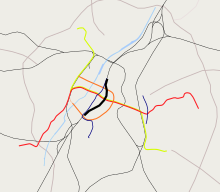North-South connection
| Brussels North–South connection | ||||||||||||||||||||||||||||||||||||||||||||||||||||||||||||||||||||||||||||||||||||||||||
|---|---|---|---|---|---|---|---|---|---|---|---|---|---|---|---|---|---|---|---|---|---|---|---|---|---|---|---|---|---|---|---|---|---|---|---|---|---|---|---|---|---|---|---|---|---|---|---|---|---|---|---|---|---|---|---|---|---|---|---|---|---|---|---|---|---|---|---|---|---|---|---|---|---|---|---|---|---|---|---|---|---|---|---|---|---|---|---|---|---|---|

The North-South connection (bold black)
in relation to other Brussels railway and metro lines |
||||||||||||||||||||||||||||||||||||||||||||||||||||||||||||||||||||||||||||||||||||||||||
| Overview | ||||||||||||||||||||||||||||||||||||||||||||||||||||||||||||||||||||||||||||||||||||||||||
| Status | Operational | |||||||||||||||||||||||||||||||||||||||||||||||||||||||||||||||||||||||||||||||||||||||||
| Locale | Belgium | |||||||||||||||||||||||||||||||||||||||||||||||||||||||||||||||||||||||||||||||||||||||||
| Termini |
Brussels-North railway station Brussels-South railway station |
|||||||||||||||||||||||||||||||||||||||||||||||||||||||||||||||||||||||||||||||||||||||||
| Operation | ||||||||||||||||||||||||||||||||||||||||||||||||||||||||||||||||||||||||||||||||||||||||||
| Opened | 1952 | |||||||||||||||||||||||||||||||||||||||||||||||||||||||||||||||||||||||||||||||||||||||||
| Operator(s) | National Railway Company of Belgium | |||||||||||||||||||||||||||||||||||||||||||||||||||||||||||||||||||||||||||||||||||||||||
| Technical | ||||||||||||||||||||||||||||||||||||||||||||||||||||||||||||||||||||||||||||||||||||||||||
| Line length | 3.8 km (2.4 mi) | |||||||||||||||||||||||||||||||||||||||||||||||||||||||||||||||||||||||||||||||||||||||||
| Number of tracks | six tracks | |||||||||||||||||||||||||||||||||||||||||||||||||||||||||||||||||||||||||||||||||||||||||
| Track gauge | 1,435 mm (4 ft 8 1⁄2 in) standard gauge | |||||||||||||||||||||||||||||||||||||||||||||||||||||||||||||||||||||||||||||||||||||||||
| Electrification | 3 kV DC | |||||||||||||||||||||||||||||||||||||||||||||||||||||||||||||||||||||||||||||||||||||||||
|
||||||||||||||||||||||||||||||||||||||||||||||||||||||||||||||||||||||||||||||||||||||||||
The North–South connection (French: Jonction Nord-Midi, Dutch: Noord-Zuidverbinding) is a railway link of national and international importance through the centre of Brussels, Belgium, that connects the major railway stations in the city. It is line 0 (zero) of the Belgian rail network. With 1200 trains a day it is the busiest railway line in Belgium and the busiest railway tunnel in the world. It has six tracks and is used principally for passenger trains. It is partially underground (around Brussels Central station) and partially raised above street level.
Brussels was served by two main railway stations: Brussels North (opened 1846) and Brussels South (opened 1869, replacing a nearby station of 1840). They are located just outside opposite ends of the Pentagon – a ring of roads which follow the boundary of the old city walls. Shortly after opening, both stations were handling large volumes of commuter, regional and international passengers, but through journeys required disembarking and a street-level transfer through the city's old town, a distance of over 3 kilometres (2 mi).
The idea of an underground railway line linking the two stations was first suggested in the 1860s as part of a proposal for the covering of the Senne. That proposal was never implemented. The current version was planned before World War II, after a decision originally made in 1909, and it came into service on 5 October 1952. Both stations were demolished and reconstructed to allow through services, reopening in 1952.
Three new intermediate stations were constructed along the route to serve the city centre. Two of them, Brussels Chapel and Brussels Congress, were intended stops only for local commuter services and have never been heavily used. The largest of the new stations, Brussels Central, was built to additionally serve regional and international services transiting through Brussels. The combination of a city-centre location and numerous services to diverse destinations led to Brussels Central becoming the busiest station in Belgium. Brussels North, Brussels Central and Brussels South are now the three main railways stations in the city; they are also the three busiest stations in all of Belgium.
...
Wikipedia
